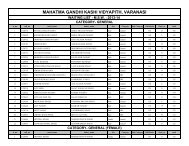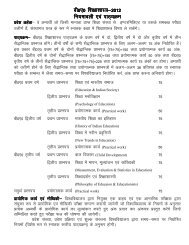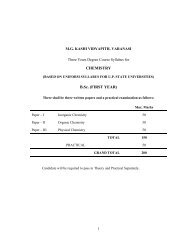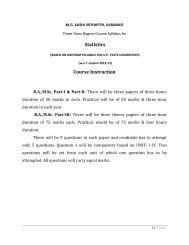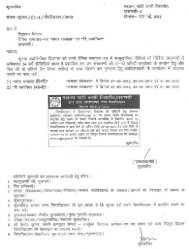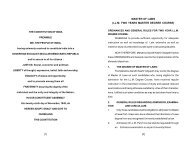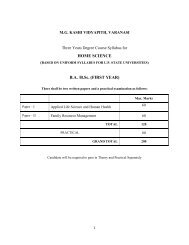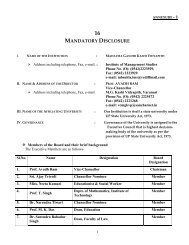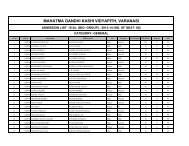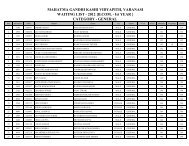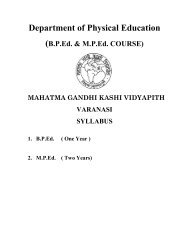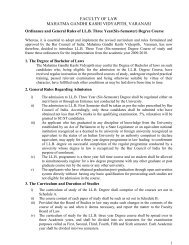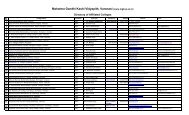M.Ed. (Syllabus and Rules & Regulations) - Mahatma Gandhi Kashi ...
M.Ed. (Syllabus and Rules & Regulations) - Mahatma Gandhi Kashi ...
M.Ed. (Syllabus and Rules & Regulations) - Mahatma Gandhi Kashi ...
Create successful ePaper yourself
Turn your PDF publications into a flip-book with our unique Google optimized e-Paper software.
M.<strong>Ed</strong>. (<strong>Syllabus</strong> <strong>and</strong> <strong>Rules</strong> & <strong>Regulations</strong>)1. In M.<strong>Ed</strong>. course there will be seven papers. Each question paper will be of 100marks. For passing it will be essential to score 33% marks in each paper alongwith 36% marks in total. For securing second division it will be required to scoremore than 48% <strong>and</strong> less than 60% marks. For securing first division it will berequired to score 60% or more than 60% marks.2. Details of the papers is as follows:A. Compulsory papers:I Paper - Philosophical & Sociological foundations of <strong>Ed</strong>ucation. 100II Paper - Psychological foundation of <strong>Ed</strong>ucation. 100III Paper - <strong>Ed</strong>ucational Research & Statistics. 100B. Elective optional papers:IV & V Papers – Any two optional papers should be selected out of thefollowing papers:(i) Technology in Teaching Behaviour. 100(ii) Comparative <strong>Ed</strong>ucation. 100(iii) Guidance <strong>and</strong> Counselling in <strong>Ed</strong>ucation. 100(iv) Distance <strong>Ed</strong>ucation. 100(v) Technology of Programmed Learning 100(vi) <strong>Ed</strong>ucational Management <strong>and</strong> Administration. 100(vii) <strong>Ed</strong>ucation for special children 100(viii) Value <strong>and</strong> Peace <strong>Ed</strong>ucation. 100VI Paper Dissertation. 100VII Paper Viva-Voce & Unit test. 100Viva-Voce conducted in all the papers will be of 25 marks.Unit test will be of 75(15*5) marks.3. The Head of Department can implement this syllabus in the respective departmentas per convenience for the students who have secured admission on regular basis.4. Admission to the M.<strong>Ed</strong>. course will be given on the basis of marks secured in theentrance test organized by the university.5. M.<strong>Ed</strong>. course will be completed in one session.6. The Head of Department with the help of the departmental committee will decideabout the eligibility of the students to appear in the examination. Each studentmust attain 75% of attendance in order to be eligible to appear in the examination.In order to maintain the expected quality of the course, a committee will beformed by the Vice Chancellor in convener ship of the Head of Departmentwhose recommendations will be implemented from time to time.7. Dissertation will be evaluated by internal <strong>and</strong> external examines out of 75 markseach separately <strong>and</strong> the examinee will be given average marks. Viva-voce will beheld by the Head of Department <strong>and</strong> external examiner under the convener ship ofthe Head of Department.
M.<strong>Ed</strong>. (First Paper)Philosophical <strong>and</strong> Sociological foundation of <strong>Ed</strong>ucationObjectives – After studying the paper, students will be able to –1. Underst<strong>and</strong> the importance of <strong>Ed</strong>ucational Philosophy <strong>and</strong> relation betweenPhilosophy <strong>and</strong> <strong>Ed</strong>ucation.2. Discriminate among different branches of western philosophy.3. Explain the different branches of Indian & Western philosophy.4. Underst<strong>and</strong> the modern trends of <strong>Ed</strong>ucation.5. Evaluate the role of <strong>Ed</strong>ucation in social change.6. Analyse the economics of <strong>Ed</strong>ucation.Part – 1Philosophical Foundation of <strong>Ed</strong>ucationUnit 1-A. Relation between education <strong>and</strong> philosophy, Importance of <strong>Ed</strong>ucationalphilosophy, meaning <strong>and</strong> objectives of <strong>Ed</strong>ucation in different political system,Branches of western philosophy: Idealism, Realism, Naturalism, Pragmatism,Existentialism <strong>and</strong> their educational objectives, curriculum, methods of teaching<strong>and</strong> discipline.B. Branches of Indian philosophy – Samkhya, Vedantya <strong>and</strong> Buddhist – Basicprinciples <strong>and</strong> their <strong>Ed</strong>ucational implications, Modern Indian <strong>Ed</strong>ucationalphilosophers- <strong>Mahatma</strong> G<strong>and</strong>hi, Tagore, Shri Aurovindo <strong>and</strong> Swami Vivekan<strong>and</strong>,their propounded principles <strong>and</strong> applications.Unit 2-A. National values, education <strong>and</strong> human rights in Indian constitution.B. Modern trends <strong>and</strong> <strong>Ed</strong>ucational innovation in <strong>Ed</strong>ucation.Unit 3-Part – 2Socialogical Foundation of <strong>Ed</strong>ucationA. Scope <strong>and</strong> meaning of Sociology – A relation between Sociology <strong>and</strong> <strong>Ed</strong>ucation,Sociology of <strong>Ed</strong>ucation- modern <strong>and</strong> new concepts: meaning, scope, nature <strong>and</strong>importance. Sociological approach <strong>and</strong> education, concept of socialization,<strong>Ed</strong>ucation: family <strong>and</strong> community in special reference to Indian society.B. Social system <strong>and</strong> education: the functional <strong>and</strong> structural scenario, education asSub-Social system, <strong>Ed</strong>ucation <strong>and</strong> social change: concept of social change,determining factors of social change, role of education, social control <strong>and</strong>education, social mobility- meaning, kinds, relation with education <strong>and</strong> theirimportance.Unit 4-A. Concept of tradition <strong>and</strong> modernization in reference to education: modernization<strong>and</strong> education- meaning <strong>and</strong> importance. <strong>Ed</strong>ucation, religion <strong>and</strong> culture: concept,relation <strong>and</strong> their importance.<strong>Ed</strong>ucation <strong>and</strong> Politics
Democracy: meaning, objectives <strong>and</strong> the role of education in development.Equality of educational opportunity: concept, factors determining opportunities<strong>and</strong> efforts done by the government.<strong>Ed</strong>ucation of Socially <strong>and</strong> economically deprived people <strong>and</strong> challenges in thisfield, achievements <strong>and</strong> the role of teacher.B. Economics of education: concept <strong>and</strong> development, education <strong>and</strong> economicdevelopment, concept of education as an investment.Need of education related to national human power. <strong>Ed</strong>ucational planning;meaning, kinds <strong>and</strong> need.Reference Books -1. Nellar, Jeorge F : Introduction of philosophy a education:Jhon willy <strong>and</strong> sons, 1971.2. Baker, Jhon L : modern philosophy of education TataMc Graw- Hill’s, 1980.3. Taneja, B.R. : Socio-Philosophical approach to education,Atlantic publication delhi, 1979.4. Verma M : Philosophy of Indian <strong>Ed</strong>ucation,Meenakshy publication, Meerut 1989.5. Bigge, Morris L : Positive relativism: An Emergenteducation philosophy, Harper row, 1971.6. Singh, Baljeet : <strong>Ed</strong>ucation an Investment, Meenakshypublication, Meerut 1984.7. P<strong>and</strong>ey K.P. : Perspectives in social foundation ofeducation. Amithabh pubilation delhi 1988.8. P<strong>and</strong>ey Ramshakal :Shiksha Darshan:Vinod pustak m<strong>and</strong>ir,19839. Ottaway, A.K.C. : <strong>Ed</strong>ucation <strong>and</strong> Society, Londol,Roultedge,1962.10. Dubey, Mukund : Indian Society: challenges if equality:Integration <strong>and</strong> empowerment, An<strong>and</strong>publication, New Delhi 1995.
M.<strong>Ed</strong>. (Second Paper)Psychological basis of <strong>Ed</strong>ucationObjectives – After studying this paper, the students will be able to –1. Underst<strong>and</strong> the meaning, scope, its Indian & Western concept <strong>and</strong> its relevancefor the teacher.2. Differentiate among different theories of learning.3. Identify the changes occurs in different stages of development <strong>and</strong> also able toidentify the different theories of development.4. Underst<strong>and</strong> the concepts of motivation <strong>and</strong> adjustment <strong>and</strong> its educationalimplication.5. Explain the concept of personality & its different theories.6. Know the concept of intelligence, its different theories <strong>and</strong> emotional intelligence.7. Identify exceptional children <strong>and</strong> able to get information about their educationalprovision <strong>and</strong> inclusive education.Unit 1-A. <strong>Ed</strong>ucational Psychology: meaning, scope, Indian & Western concept, therelevance of education psychology according to the teacher.B. Development: meaning, difference between growth & development, cognitive,social <strong>and</strong> emotional development: main characteristics & educationalimplication, Indian concept of development (with special reference to Sanskara.)C. Learning: meaning, gagnes types of learning, factor affecting learning, transfer oflearning: meaning, theory & its educational implication.Unit 2-A. Associative theory of learning: systematic behavior theory of Hull, main point <strong>and</strong>educational implication.B. Cognitive theory of learning: Gestall <strong>and</strong> Tolman theory, main point <strong>and</strong>educational implication.Unit 3-A. Motivation : concept, Indian view: purushartha chatushaya (Dhrma, Artha, Kham,Moksh) & its educational implication.B. Adjustment: Meaning , process, pattern of adjustment, mental conflict <strong>and</strong>defence mechanism, characteristics of well adjusted person, mental health <strong>and</strong>hygiene , meaning, main point & educational implication.C. Special children: Slow Learner/Backward children, Gifted, <strong>and</strong> mentally retardedchild: identification <strong>and</strong> educational provision. Inclusive education – meaning,main point <strong>and</strong> educational implication, Creativity: meaning, process,identification <strong>and</strong> fostering, Problem solving: form, process <strong>and</strong> educationalimplication.Unit 4-A. Personality : meaning, puncha koshiya development <strong>and</strong> Sata, Raja, Tam, GunaIndian concept of personality, western concept of personality & theory, Trait-Alport & Eysenck, Psychoanalytical theory -Freud <strong>and</strong> Erickson, Humanistic:Maslow <strong>and</strong> Rogers, measurement of personality
B. Intelligence: meaning, Indian <strong>and</strong> western concept, main point, some theory ofintelligence, Guilford <strong>and</strong> Gardner’s concept of intelligence, main point &educational implication, Emotional Intelligence: meaning, main point, educationalimplication, Individual difference: meaning types <strong>and</strong> educational implication,Concept formations meaning. process <strong>and</strong> educational implication.C. Group dynamics: meaning, social process, teacher’s role for making learningoriented class environment.Practical works -1. Collection <strong>and</strong> Report presentation on any concept of educational psychologyfrom ancient Indian literature.2. Critical analysis of any one of new theory related with the concept of personalityor learning or intelligence <strong>and</strong> report presentation.Reference Books:P<strong>and</strong>ey, K.P.- Advanced <strong>Ed</strong>ucational Psychology; Vishwavidyalaya Prrakashan,Varanasi.Prakash, Prem- Psychological Foundations of <strong>Ed</strong>ucation; Kanishka Publication, NewDelhi.P<strong>and</strong>ey, Kalplata- Mother’s Care <strong>and</strong> Girls Achievement; Mishra TradingChauhan, S.S.- Advanced <strong>Ed</strong>ucational Psychology; Vinod pustak M<strong>and</strong>ir, Agra.Baron, A. Robert- Psychology; Pearson. Prentice Hall.
M.<strong>Ed</strong>. (Third Paper)<strong>Ed</strong>ucational Research <strong>and</strong> StatisticsObjectives – After studying this paper, the students will be able to –1. Know the meaning <strong>and</strong> scope of educational research.2. Differentiate among fundamental, applied <strong>and</strong> action research.3. Know different methods used in <strong>Ed</strong>ucational research.4. Underst<strong>and</strong> the procedure of educational research.5. Use important tools for collection of data in educational research.6. Use statistical techniques for the analysis <strong>and</strong> interpretation of data.Section - AUnit 1-A. Meaning of educational research, scope, various forms of educational research-Fundamental, applied <strong>and</strong> action research: difference among them on the basis ofobjectives, nature of problem, method <strong>and</strong> utility of research result.B. Methods of educational research – Historical, Descriptive survey, experimental,ex-post facto <strong>and</strong> case study: procedures <strong>and</strong> needed precautions, Qualitativeresearch.C. Procedure of educational research-(I) Problem of research – Selection of problem, Definition <strong>and</strong> delimitation.(II) Formulation of hypothesis – Procedure, source <strong>and</strong> characteristics of a goodhypothesis.(III) Hypothesis testing.(IV) Formulation of Generalization <strong>and</strong> conclusion.Unit 2-A. Determination of population <strong>and</strong> sampling technique in educational research –Meaning of population in research, needs of sample, characteristics of a goodsample, probability <strong>and</strong> non- probability sampling methods: procedure <strong>and</strong>limitation.B. Tools of educational research – Characteristics of research tool, its using method<strong>and</strong> requisite precautions, Questionnaires, Interview, Observation, Rating scale,Tests, Sociometric technique.C. (I) Research report – Format <strong>and</strong> Process of research report writing.(II) Preparation of research synopsis – Format <strong>and</strong> precautions.Section - BUnit 3-A. . Measures <strong>and</strong> use of central tendency – Mean, Median <strong>and</strong> Mode. Measures <strong>and</strong> use of Variability – Range, Mean – deviation, St<strong>and</strong>ard –deviation, Quartile – deviation. Utility <strong>and</strong> methods for calculating percentile <strong>and</strong> percentile rank.B. Graphical representation of scores.
C. Correlation – Meaning of Correlation, calculation <strong>and</strong> interpretation of coefficientof correlation by spearman <strong>and</strong> Carl pearson’s methods, partial correlation <strong>and</strong>Multiple correlation.Unit 4-A. Properties <strong>and</strong> application of Normal probability curve.B. Reliability of statistics of estimation <strong>and</strong> Inference: significance of mean, testingthe significance of differences between two means, directional <strong>and</strong> nondirectionaltests, Types of errors.Analysis of Variance: Assumptions underlying <strong>and</strong> method of computing one wayAnalysis of Variance.C. Chi-square <strong>and</strong> Contingency coefficient: calculation <strong>and</strong> application.Reference Books:Ch<strong>and</strong>ak<strong>and</strong>an, K, Karthikeyen, C.- Behavioural Research Methodology; Banarasidas.P<strong>and</strong>ey, K.P.- Fundamentals of <strong>Ed</strong>ucational Research; Vishwavidyalaya Prrakashan,Varanasi.Pathak, R.P.- Statistics in <strong>Ed</strong>ucational Research; Kanishka Publication, New Delhi.Sharma, N.K.- Statistical Techniques.Garrett, Henry- Statistics in Psychology <strong>and</strong> <strong>Ed</strong>ucation, Kalyani Publishers, New Delhi.
M.<strong>Ed</strong>. (Fourth <strong>and</strong> Fifth Paper)Guidance <strong>and</strong> Councelling in <strong>Ed</strong>ucationObjectives – After studying this paper, the students will be able to –1. To underst<strong>and</strong> the importance <strong>and</strong> application of guidance in their daily life.2. To know the principles, modern trend <strong>and</strong> problems of guidance.3. To underst<strong>and</strong> different types of guidance <strong>and</strong> counseling.4. To use different techniques of guidance <strong>and</strong> counseling for problem solving.5. To use different psychological <strong>and</strong> evaluative techniques of guidance.6. To underst<strong>and</strong> different tools <strong>and</strong> methods of guidance <strong>and</strong> counseling.Unit 1-A. Guidance – concept, need, scope, principles, nature <strong>and</strong> modern tendencies.B. History of Guidance movement in Indian, suggestions related to Guidance invarious education commissions.C. Present situation <strong>and</strong> problems of Guidance in Indian context.Unit 2-A. Kinds of Guidance – <strong>Ed</strong>ucational, Vocational, Personal – objectives, difference<strong>and</strong> applied techniques.B. Organization <strong>and</strong> Administration of Guidance Programs in Schools.Unit 3-A. Types of Guidance services at various levels of education.1) Information service.2) Individual information collection3) Vocational information: sources, collection <strong>and</strong> broad cast.4) Counselling service5) Officiating service6) Follow up service7) Research service8) Firm serviceB. Councelling: concept, principle, steps, process of councelling <strong>and</strong> characteristicsof a Good Counsellor.Unit 4-A. Tools <strong>and</strong> Techniques of Guidance, Psychological test <strong>and</strong> evaluation in guidance.B. Evaluation of Guidance Programme- various techniques <strong>and</strong> utility of evaluation.Practical works - To present report by running Counselling session of 5 students on the basis ofcase study for solving their problems. Preparation of a report by using any two tools of evaluation for guidance.
4. Chaturvedi, R.N. (1989) The Administration Of <strong>Ed</strong>ucation In India, Jaipur,Printwell Publication.5. Goyal, S.L. (2005) Management In <strong>Ed</strong>ucation, New Delhi, A.P.H. PublicationCorporation.6. Gupta L.D. (1987) <strong>Ed</strong>ucational Administration, Oxford <strong>and</strong> I.B.H.7. Mathur S.S.: <strong>Ed</strong>ucational Administration, Principles <strong>and</strong> Practices.8. Nistred, R.O. Etal (1983) Sydey, Allen <strong>and</strong> Bacon, Iuk.9. Ray Choudhary, Namita (1992) Management in <strong>Ed</strong>ucation, New Delhi, A.P.H.P.
M.<strong>Ed</strong>. IV th & V th paperComputer -Assisted Learning <strong>and</strong> TeachingObjectives – After studying this paper, the students will be able to –1) To know the utility of Computer in the Teaching-Learning of language & othersubjects.2) To get the information related to Computer hardware & software.3) To underst<strong>and</strong> the utility <strong>and</strong> functioning of internet.4) To design a Programme for computer.5) To know about the modern trends in the field of information technology.6) To explain the researches done in the field of Computer Learning.Unit 1-A. Role of Computer in Teaching-Learning of language & other subjects: role ofComputer in Learning environment, historical perspective of computer-assistedinstruction <strong>and</strong> its social, educational & technological implications, computer <strong>and</strong>Indian school.B. Micro computer, Input & Output techniques, Computer peripherals.Unit 2-A. Computer Hardware <strong>and</strong> Software – Introduction of useful software, operatingsystem & computer related useful language.B. Concept of internet, general information about the multimedia <strong>and</strong> graphics.Unit 3-A. Information technology <strong>and</strong> education.B. Utility of Computer in the field of education, computer software’s constructionprocedure, project design, its execution <strong>and</strong> monitoring.Unit 4-A. Condition of expected research in the field of computer-assisted instruction,construction of research design.B. Computer based Learning packages for science <strong>and</strong> other subjects <strong>and</strong> itsevaluation, library management <strong>and</strong> desirable precautions for management ofcomputers in schools.Practical works - To develop a program for computer. Teaching of 5 to 10 lesson plan using computer in selected subjects.Reference Books-1. Chauhan, S.S.- Innovations in Teaching Learning Process, Vikas publication, NewDelhi.2. Dhama, O.P, Bhatnagar, O.P- <strong>Ed</strong>ucation <strong>and</strong> Commuication for development, Oxford<strong>and</strong> JBH.3. Addy, S.- Fundamentals of Computer Science.4. Sinha, P.K.- Computer Fundamentals.
M.<strong>Ed</strong>. IV th & V th paperTechnology of Teaching BehaviourObjectives – After studying this paper, the students will be able to –1. Underst<strong>and</strong> the meaning of Technology, contemporary trends <strong>and</strong> different types.2. Analyse the Teaching-Learning Relationship <strong>and</strong> different stages of Teaching<strong>and</strong> its operations.3. Differentiate among the different types of learning.4. Explain the different models of teaching.5. Utilise the different approaches of Teaching Communication.6. Underst<strong>and</strong> the Teaching Behaviour <strong>and</strong> different techniques of its modification.7. Write <strong>and</strong> evaluate the program according to the Programmed Instruction.Unit 1-A. Technology: Meaning, Scope <strong>and</strong> Modern trends, Behavioural Technology,Instructional Technology, Teaching Technology, Instructional Design-Nature <strong>and</strong>Scope.B. Teaching-Learning Relationship: Types of Teaching, stages of Teaching <strong>and</strong> itsoperations.C. Levels of Teaching: Memory Level, Underst<strong>and</strong>ing Level, Reflective Level-Nature, related theories, Teaching <strong>and</strong> testing methods.Unit 2-A. Different types of Learning –skill, verbal knowledge, concept, rule <strong>and</strong> stepsincluded in teaching of Problem-Solving Learning.B. Models of Teaching: Concept, need <strong>and</strong> important elements, classification ofTeaching Models, some selected models of Teaching – Basic Teaching Model,School Learning Model, Concept Attainment Model <strong>and</strong> Psychological Modelelements,characteristics <strong>and</strong> implications for teacher.Unit 3-A. Concept of Teaching Behaviour: characteristics <strong>and</strong> nature, systematic form ofclass-room behaviour, strategies <strong>and</strong> techniques, difference between teachingbehavior <strong>and</strong> teacher behavior.B. Methods of Modification of Teaching Behaviour: Micro-Teaching, SimulatedTeaching-concept <strong>and</strong> application.C. Systematic observation of Teaching: Fl<strong>and</strong>er’s Interaction Analysis(FICS),Categories-Reciprocal category system(RCS) <strong>and</strong> Equivalent Talk categorysystem(ETCS).Unit 4-A. Communication: Theories, types, process, <strong>and</strong> medium- classification of medium.B. Programmed Instruction: Origin, concept <strong>and</strong> Types-Linear, Branching <strong>and</strong>Mathetics, Development of program, Writing <strong>and</strong> evaluation of programe,Contribution of Computer-Assisted Instruction <strong>and</strong> Information Technology inTeaching.
Practical work - Construction of Teaching Plan on the basis of any one Teaching Model <strong>and</strong> atleast 10 interaction matrix by using any one systematic observation method.Reference books-1. Sharma, R.A.- Technological Foundation of <strong>Ed</strong>ucation, R.Lal publishers.2. Kumar, K.L.- <strong>Ed</strong>ucational Technology, New Age International publishers.3. P<strong>and</strong>ey, K.P.- Modern concepts of teaching behavior, Vishwavidyalaya Prakashan,Varanasi.4. Vanaja, M.- <strong>Ed</strong>ucational Technology, Neel Kamal Publications, New Delhi.
M.<strong>Ed</strong>. IV th & V th paperDistance <strong>Ed</strong>ucationObjectives – After studying this paper, the students will be able to –1) Know about the concept of distance education <strong>and</strong> its relevance in India <strong>and</strong>foreign countries.2) Underst<strong>and</strong> the nature <strong>and</strong> responsibility of students <strong>and</strong> teachers <strong>and</strong> relatedproblems.3) Differentiate among various media used in distance education.4) Know the process of self instructional materials in distance education.5) Evaluate the organizational nature of distance education.6) Acquaint with the researches being conducted in the field of distance education.Unit 1-A. Distance <strong>Ed</strong>ucation- Concept, need, scope <strong>and</strong> its relevance in the presenteducational context. Development of distance education in India <strong>and</strong> its presentstatus <strong>and</strong> its status in other countries such as- China, Canada, Engl<strong>and</strong>, America<strong>and</strong> France.B. Philosophical foundation of distance education- Theories of Michal Moore,Charles Vedemeyor, Holmberg <strong>and</strong> Peters <strong>and</strong> their educational implications.Unit 2-A. Distance <strong>Ed</strong>ucation <strong>and</strong> Teacher: nature, responsibilities, qualities, problem <strong>and</strong>training.B. Distance <strong>Ed</strong>ucation <strong>and</strong> students: nature, characteristics, student support services<strong>and</strong> their relevance from the point of view of the nature of Distance <strong>Ed</strong>ucation.Unit 3-A. Distance <strong>Ed</strong>ucation <strong>and</strong> media: Print <strong>and</strong> non print media <strong>and</strong> their use inDistance <strong>Ed</strong>ucation, process of preparation of print materials <strong>and</strong> precautionsneeded.B. Organization of Distance <strong>Ed</strong>ucation: nature, regional <strong>and</strong> local study center:nature, functions <strong>and</strong> its relevance.Unit 4-A. Concept of Evaluation in Distance <strong>Ed</strong>ucation: Various techniques <strong>and</strong> theirapplication in evaluation.B. Research in Distance <strong>Ed</strong>ucation: Present situation <strong>and</strong> main points of researchesto be done in future.Experimental Work- Case study <strong>and</strong> presentation of report of any study center of Distance <strong>Ed</strong>ucation. Preparation of self instructional material on any topic. Evaluation of one assignment using any technique used in Distance <strong>Ed</strong>ucation.
Reference Books -Keegasn, D. Foundations Of Distance <strong>Ed</strong>ucation,London, Routeledge,1990.P<strong>and</strong>ey, K. Shiksha Ke Naye Ayaam, Doorvasti Shiksha,1987.Raj Shalim Distance <strong>Ed</strong>ucation, IVY Publishing House, New Delhi, 2004.Sharma, R.A. Doorvasti Shiksha, Meerut, Surya Publication,1996.Shau, P.K. Open Learning System, New Delhi, Uppal Publication,1994.Gupta, S.P.& Gupta A. Doorvasti Shiksha, Allahabab, Sharada Pustak Bawan.2003.
M.<strong>Ed</strong>. IV th & V th paper<strong>Ed</strong>ucation for Special ChildrenObjectives – After studying this paper, the students will be able to –1) Underst<strong>and</strong> special children <strong>and</strong> their special educational needs.2) Rcognize the problems of disabled children.3) Give suggestions for arrangement of special education for completely deaf <strong>and</strong>dumb children.4) Analyse the condition of deprived <strong>and</strong> causes of deprivation.5) Evaluate facilities given to mentally disabled children in India <strong>and</strong> world.6) Construct study material for education of special children.Unit 1-A. Special Children: Meaning <strong>and</strong> Types, Need of special education, Application &importance.B. Disability: Meaning of disability, adjustment problems of disabled, Physical <strong>and</strong>social facilities, special education system, curriculum, teaching methods <strong>and</strong>special schools.Unit 2-A. Visually Impaired <strong>and</strong> Blind children – Meaning of visual impairment,Identification, adjustment problems, special medium, Teaching arrangements orapproaches <strong>and</strong> efforts to mainstreaming them into society.B. Deaf or hearing impaired children: Meaning of hearing impaired, identification,adjustment problems, Special educational: approaches, curriculum, separateschool, Teaching method, <strong>Ed</strong>ucational medium, Teaching arrangements <strong>and</strong>efforts for rehabilitation.Unit 3-A. Speech disorders <strong>and</strong> totally dumb children : Meaning, Identification, Adjustmentproblems, Special Teaching adaptations, curriculum, separate school, Teachingmethod, Teaching medium, Teaching strategy <strong>and</strong> efforts for mainstreaming theminto society.B. Deprived children <strong>and</strong> their education. Deprived child- Meaning of deprivation,types, condition of deprived in modern social context, causes, impact ofdeprivation on intellectual, emotional, achievement <strong>and</strong> personality, role ofeducation <strong>and</strong> teacher in resettlement of deprived in society, wastage <strong>and</strong>stagnation, Facility deprived children, causes, intervention, necessity to builddifferent Psychological schools, special educational arrangement.Unit 4-A. Mental Retardation: Meaning, Identification, Types of children suffering frommental retardation, educable mentally severely or profoundly retarded children,<strong>Ed</strong>ucational arrangements in context with emotional satisfaction, remedialTeaching <strong>and</strong> construction of special curriculum, Role of <strong>Ed</strong>ucation <strong>and</strong> educatorsin rehabilitation of them in society.B. Facilities given to retarded children in India <strong>and</strong> world, Mental h<strong>and</strong>icaptness <strong>and</strong>employment based educational arrangements, curriculum, Teaching method <strong>and</strong>role of special schools.
Practical works - Case study of children belonging to any one special category among thefollowing. Visual Impairment, Hearing Impairment, Mental Retardation <strong>and</strong>orthopedic disable. Construction of special educational material for special children belonging to anyone category. Knowledge about tools <strong>and</strong> educational means to educating special child. Evaluation techniques for assessment of disabled.Reference Books:1. Rath, K.B.- Exceptional Children, R.I, Ajmer, Rajasthan.2. Kundu, C.L. (2003)- Status of disability in India, R.C.I., New Delhi.3. P<strong>and</strong>a, K.C.(1997)- <strong>Ed</strong>ucation of Exceptional Children, Vikas Publishing House, NewDelhi.4. Dash, M(1997)- <strong>Ed</strong>ucation of Exceptional Children, Atlantic publishers, New Delhi.Kenkateish, S (2001)- Special <strong>Ed</strong>ucation, Anmol Publication Pvt. Ltd., New Delhi.
M.<strong>Ed</strong>. IV th & V th paperPeace <strong>and</strong> Value <strong>Ed</strong>ucationObjectives – After studying this paper, the students will be able to–1) underst<strong>and</strong> about the Concept of value <strong>and</strong> its different category.2) underst<strong>and</strong> about the nature of peace, value <strong>and</strong> different procedures of solutionabout the conflict.3) use different techniques to enrich peace related value.4) analyze different agencies like Home, School <strong>and</strong> Community for enrichment ofpeace related value.5) underst<strong>and</strong> about the nature of peace, objectives <strong>and</strong> relevance.6) underst<strong>and</strong> about the value education <strong>and</strong> its relevance in teacher’s training.Unit 1-A. Peace – Meaning, nature <strong>and</strong> its relevancy relating to the present global scenario,Different sources of peace: philosophical, religious, social <strong>and</strong> psychological.B. Classification of peace- Positive <strong>and</strong> negative peace, concept, characteristics,remedy to minimize the negative peace <strong>and</strong> assistance of Indian thought in thisfield.C. Role of different organizations like UNESO in peace enrichment.Unit 2-A. Value- Meaning, nature <strong>and</strong> its relevance in present Global scenario.B. Classification of value.C. Role of community, school <strong>and</strong> family in the development of value.Unit 3-A. Peace education – Teaching, objectives, scope <strong>and</strong> its relevance.B. Methods for peace education.C. Ongoing researches in the field of peace education – present scenario <strong>and</strong>suggestions.Unit 4-A. Value education – Meaning, nature, objectives, scope <strong>and</strong> its relevance.B. Value education, fundamental right, duty <strong>and</strong> role of teacher.C. On going researches in the field of value education – present scenario <strong>and</strong>suggestions.Practical work - Formation of plan to enrich value in teachers. Formation of test for the measurement of peace related value. Training of the method used for solving the internal conflict <strong>and</strong> reportpresentation accordingly.Reference Books:1. Raghuvansh, Sujata- Human Rights <strong>and</strong> Duties education, Mahaveer <strong>and</strong> Sons, NewDelhi.2. Patil, V.T- Value education <strong>and</strong> Human rights <strong>Ed</strong>ucation, Gnosis Publishers.3.Chakrabarti, Mohit- Value education4.Tiwari, k.K.- <strong>Ed</strong>ucation for values.
M.<strong>Ed</strong>. IV th & V th paperTechnology of Programmed LearningObjectives – After studying this paper, the students will be able to–1) Underst<strong>and</strong>ing Historical & Psychological perspective of Programmed Learning.2) Differentiate among different types of Programmed Learning.3) Underst<strong>and</strong> the concept of mastery learning.4) Write programme.5) Evaluate the programme.6) St<strong>and</strong>ardization <strong>and</strong> construction of criterion test for programme.Unit 1-A. Meaning, Origin, basic fundamentals <strong>and</strong> future of programmed learning.B. Historical & Psychological Perspective of programmed learning. Relationship ofconnectionism of Thorndike & operant conditioning with programmed learning.Unit 2-A. Types of Programmed Learning – characteristics, types, assumptions <strong>and</strong>examples of linear, branching & mathetics programme.B. Retrogressive programme – characteristics, assumptions, steps & examples.Unit 3-A. Mastery Learning: Meaning, Steps, Examples <strong>and</strong> speciality. Teaching tools –Meaning & Characteristics.B. Planning of Program- Selection of topic, analysis of content, meaning ofbehavioural objectives <strong>and</strong> its example, construction of criterion test.Unit 4-A. Programmed writing – structural & functional elements of programme, Types offrames, priming, prompting <strong>and</strong> types of prompts, Sequencing of frames: logical& empirical sequence, <strong>Ed</strong>ition & Correction of Programme. Types of <strong>Ed</strong>itions.B. Testing & Evaluation of the Programme: Individual, small group & Error of Fieldtesting Programme, Information density <strong>and</strong> 90/90 st<strong>and</strong>ardised rate.Practical works -To present Linear & Branching style programme on any topic, to describe theterminal Behaviour in this programme, to formulate objectives in behavioural term,presentation of 100-150 frames in the programme <strong>and</strong> construction of criterion testrelated to it.Reference Books:1. Jain, Satish- Computer fundamentals <strong>and</strong> C++ programming.2. Maurya, Omprakash- Basic Programming.3. Rao, Usha- <strong>Ed</strong>ucational Technology.4. Vashist, S.R.- Research in <strong>Ed</strong>ucational Technology.5. Yadav, R.S.- An Advanced <strong>Ed</strong>ucational Technology.6. Sharma, R.A.- Technological Foundation of <strong>Ed</strong>ucation., SuryaPublication, Meerut.
M.<strong>Ed</strong>. IV th & V th paperComparative <strong>Ed</strong>ucationObjectives – After studying this paper, the students will be able to–1. Know about the changes in the field of education at the world level.2. Underst<strong>and</strong> geographical, political, cultural <strong>and</strong> educational scenario of differentcountries.3. Underst<strong>and</strong> the necessity of education in the root of development of developedcountries.4. Know the various educational problems of the developing <strong>and</strong> developedcountries.5. Change their skill <strong>and</strong> thought by the critical study of educational administrationof different countries.6. Carry on the comparative study of the educational scenario of Britain, America,France <strong>and</strong> India.Unit 1-A. Meaning of Comparative <strong>Ed</strong>ucation, scope, development, aims <strong>and</strong> studymethods.B. Factors affecting comparative education, International assistance in thedevelopment of National <strong>Ed</strong>ucation System.Unit 2-A. Structure, organization <strong>and</strong> nature of education in India <strong>and</strong> Britain.B. Nature <strong>and</strong> problems of educational structure of primary, secondary <strong>and</strong> highereducation in India <strong>and</strong> Britain.C. Problems of nature <strong>and</strong> organization of education in Britain, America, France <strong>and</strong>India.Unit 3-A. <strong>Ed</strong>ucational structure <strong>and</strong> its functioning in Britain, America, France <strong>and</strong> India.B. Implications of technical <strong>and</strong> vocational education for India.Unit 4-A. <strong>Ed</strong>ucational autonomy in India, France <strong>and</strong> America.B. Distance education in India, Britain <strong>and</strong> America <strong>and</strong> its implications for India.Reference Books:1. P<strong>and</strong>ey, K.P.- Comparative <strong>Ed</strong>ucation2. Mukherji, N.N.- <strong>Ed</strong>ucation in India: Today <strong>and</strong> Tomorrow.3. Cramer <strong>and</strong> Crown- National System of <strong>Ed</strong>ucation4. Kendel- New era in <strong>Ed</strong>ucation5. Dent, H.C.- <strong>Ed</strong>ucation in Great Britain.



